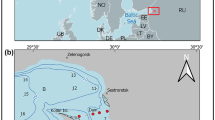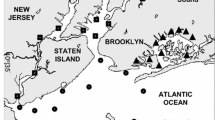Abstract
The amount of photosynthetically active radiation (PAR) in the water column is of fundamental importance in determining the growth of aquatic plant and aquatic primary production. Light attenuation in aquatic ecosystems has important ecological implication and water quality applications. In the present study, the light attenuation through the water column in the Shihmen Reservoir, Taiwan was measured. A light attenuation coefficient (K e) can be derived from the PAR measurements at each stations. The linear regression analysis reveals that Secchi disk depth is a sample alternative measure of light transmitability and provides a reasonable estimate of the light attenuation coefficient in the Shihmen Reservoir. We conducted multiple-regression analysis for the K e, chlorophyll a, and total suspended solids (TSS). Because the concentration of chlorophyll a is roughly <5 µg/L in the Shihmen Reservoir, the chlorophyll contribution to the attenuation coefficient will be <0.1 m−1, which is negligible. K e correlated with TSS concentration yields a good correlation, indicating the TSS should be a good water quality variable for predicting water column light attenuation coefficient in the Shihmen Reservoir.







Similar content being viewed by others
References
Backman TW, Barilotti DC (1976) Irradiance reduction effects on standing crops of the Eelgrass Zosteramarina in a coastal lagoon. Mar Biol 34(1):33–40
Batiuk R, Orth R, Moore K, Dennison W, Stevenson J, Staver L, Carter V, Rybicki N, Hickman R, Kollar S, Bieber S, Heasly P (1992) Chesapeake Bay submerged aquatic vegetation habit requirements and restoration targets: a technical synthesis. CBP/TRS 83/92, United States Environmental Protection Agency Chesapeake Bay Program, Annapolis
Cambridge ML, McComb AJ (1984) The loss of seagrasses in Cockburn Sound, West Australia. I. The time course and magnitude of seagrass declines in relation to industrial development. Aquat Bot 20(3–4):229–243
Christian D, Sheng YP (2003) Relative influence of various water quality parameters on light attenuation in Indian River lagoon. Estuar Coast Shelf Sci 57(5–6):961–971
Davies-Colley RJ, Smith DG (2001) Turbidity, suspended sediment, and water clarity: a review. J AmWater Resour Assoc 37(5):1085–1101
Dennison WC, Orth RJ, Moore KA, Stevenson JC, Carter V, Kollar S, Bergstorm PW, Batiuk RA (1993) Assessing water quality with submersed aquatic vegetation: habitat requirements as barometers of Chesapeake Bay health. Bioscience 43(2):86–94
Duarte CM, Kalff J (1987) Latitudinal influences on the depths of maximum colonization and maximum biomass of submerged Angiosperms in lakes. Can J Fish Aquat Sci 44(10):1759–1764
Effler SW (1985) Attenuation versus transparency. J Environ Eng-ASCE 111(4):448–459
Field SD, Effler SW (1983) Light attenuation in Onondaga Lake, NY, USA, 1978. Arch Hydrobiol 98(4):409–421
Holmes R (1970) The Secchi disk in turbid coastal water. Limnol Oceanogr 15(5):688–694
James WF, Best EP, Barko J (2004) Sediment resuspension and light attenuation in Peoria Lake: can macrophytes improve water quality in this shallow systems? Hydrobiology 515(1–3):193–201
Jamu DM, Lu Z, Piedrahita RH (1999) Relationship between Secchi disk visibility and chlorophyll a in aquaculture ponds. Aquaculture 170(3–4):205–221
Jerlov NG (1968) Optical oceanography. Elsevier, Amsterdam
Kemp WM, Twilley RR, Stevenson JC, Boyton WR, Mwans JC (1983) The decline of submerged vascular plants in upper Chesapeake Bay: summary of results concerning possible causes. Mar Technol Soc J 17(22):78–89
Kim KS, Je CH (2004) Phytoplankton estimation using plant primary production rates in streams. Environ Geol 46(1):10–14
Kirk JTO (1975) A theoretical analysis of the contribution of algal cells to the attenuation of light within natural waters. 1. General treatment of suspension of pigmented cells. New Phytol 75:11–20
Kirk JTO (1994) Light and photosynthesis in aquatic ecosystems. Cambridge University Press, Cambridge
Langenberg VT, Mwaoe LM, Tshibangu K, Tumba JM, Koelmans AA, Roijackers R, Salonen K, Sarvala J, Molsa H (2002) Comparison of thermal stratification, light attenuation and chlorophyll-a dynamics between the ends of Lake Tanganyika. Aquat Ecosyst Health Manag 5(3):255–265
Lawson SE, Wiberg PL, McGlathery KJ, Fugate DC (2007) Wind-driven sediment suspension controls light availability in a shallow coastal lagoon. Estuaries Coasts 30(1):102–112
Loiselle SA, Azza N, Cozar A, Bracchini L, Tognazzi A, Dattilo A, Rossi C (2008) Variability in factors causing light attenuation in Lake Victoria. Freshw Biol 53(3):535–545
Megard RO, Settles JC, Boyer HA, Combs WS (1980) Light, Secchi disks, and trophic states. Limnol and Oceanogr 25(2):373–377
Middleboe AL, Markager S (1997) Depth limits and minimum light requirements of freshwater macrophytes. Freshw Biol 37(3):553–568
Mobley CD, Gentili B, Gordon HR, Jin Z, Kattawar GW, Morel A, Reinersman P, Stamnes K, Stavn RH (1993) Comparison of numerical models for computing underwater light fields. Appl Optics 32(36):7484–7504
Orth RJ, Moore KA (1983) Chesapeake Bay: an unprecedented decline in submerged aquatic vegetation. Science 22(4619):5153
Padial AA, Thomaz SM (2008) Prediction of the light attenuation coefficient through the Secchi disck depth: empirical modeling in two large Neotropical ecosystems. Limnol 9(2):143–151
Prieur L, Sathyendranath S (1981) An optical classification of coastal and oceanic water based on the specific spectral absorption curves of phytoplankton pigments, dissolved organic matter, and other particulate materials. Limnol Oceanogr 26(4):671–689
Schanz F (1985) Vertical light attenuation and phytoplankton development in Lake Zurich. Limnol Oceanogr 30(2):299–310
USEPA (1983) Methods for chemical analysis of water and waste. US Environmental Protection Agency, Washington, DC
USEPA (2000) Chesapeake Bay submerged aquatic vegetation water quality and habitat-based requirements and restoration targets: a second technical synthesis
Van Duin EHS, Blom G, Los FJ, Maffione R, Zimmerman R, Cerco CF, Dorch M, Best EPH (2001) Modeling underwater light climate in relation to sedimentation, resuspension, water quality and autotrophic growth. Hydrobiol 444:25–42
Williamson CE, Stemberger RS, Morris DP, Frost TM, Paulsen SG (1996) Ultraviolet radiation in North American lakes: Attenuation estimates from DOC measurements and implications for plankton communities. Limnol Oceanogr 41(5):1024–1034
Yagobi YZ (2006) Temporal and vertical variation of chlorophyll a concentration, phytoplankton photosynthetic activity and light attenuation in Lake Kinneret: possibilities and limitations for simulation by remote sensing. J Plankton Res 28(8):725–736
Zhang YL, Qin BQ, Chen WM, Yang DT (2004) Regression analysis of beam attenuation coefficient under water in Lake Taihu. Oceanologia Et Limnologia Sinica 35(3):209–213
Acknowledgments
The field measurements were supported by the Northern Region Water Resources Bureau, Water Resources Agency, Taiwan. The assistances of Mr. Wen-Hsiung Hsieh and Dr. Chi-Ray Wu in the field measurement and analysis of water samples are acknowledged.
Author information
Authors and Affiliations
Corresponding author
Rights and permissions
About this article
Cite this article
Liu, WC., Wu, RS., Wu, E.MY. et al. Using water quality variables to predict light attenuation coefficient: case study in Shihmen Reservoir. Paddy Water Environ 8, 267–275 (2010). https://doi.org/10.1007/s10333-010-0207-5
Received:
Revised:
Accepted:
Published:
Issue Date:
DOI: https://doi.org/10.1007/s10333-010-0207-5




